Soccer games are played in school playgrounds, backyards, and fields worldwide, soccer can be enjoyed in many ways. However, there are countless interpretations of the soccer rules.
In today’s article, we discuss just the 17 rules of soccer. We look at each law individually to make complex rules easy to understand.
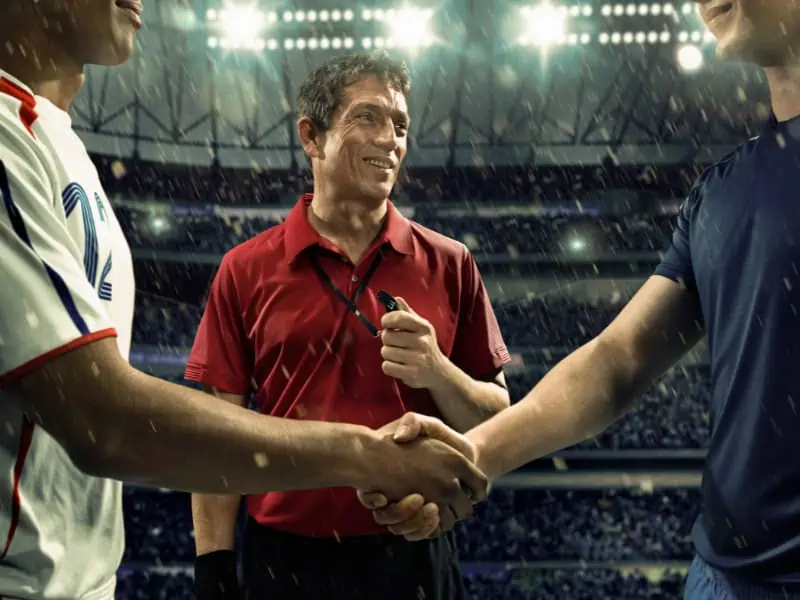
What Are The Rules Of Soccer?
The rules of soccer, or the Laws of the Game, are a set of official regulations that help keep the game fair for everyone.
While certain interpretations of the rules are specific to individual countries, the fundamental Laws of the Game are consistent throughout soccer.
All games operate under the same general ruleset from the FIFA World Cup to the MLS. The International Football Association Board (IFAB) is the governing body that oversees and determines the official Laws of the Game.
The organization was established in 1886 to create standardized rules to make soccer a more global sport. FIFA, one of the most influential governing bodies in the sport, recognizes IFAB’s role in managing the rules.
However, FIFA is heavily involved in any work by IFAB and has a 50% say in voting rights. If changes to any laws are to be made, a 75% supermajority vote is required.
Therefore, FIFA must demonstrate its support to pass any significant amendments. IFAB takes the role seriously and often adopts a slow, methodical, and usually conservative approach toward any changes.
However, they are responsible for some, if not all, of the most influential rules created in recent decades. A short snippet of IFAB’s philosophy and spirit encapsulates its vision surrounding the game:
“Football must have Laws which keep the game fair – this is a crucial foundation of the ‘beautiful game’ and a vital feature of the ‘spirit’ of the game. The best matches are those where the referee is rarely needed because the players play with respect for each other, the match officials and the Laws.”
IFAB, 2021
17 Rules of Soccer
There are 17 official Laws of the Game. Each law is divided into separate subcategories. The 17 Laws of the Game are as follows:
- Law 1: The Field of Play
- Law 2: The Ball
- Law 3: The Players
- Law 4: The Players’ Equipment
- Law 5: The Referee
- Law 6: The Other Match Officials
- Law 7: The Duration of the Match
- Law 8: The Start and Restart of Play
- Law 9: The Ball In and Out of Play
- Law 10: Determining The Outcome of a Match
- Law 11: Offside
- Law 12: Fouls and Misconduct
- Law 13: Free Kicks
- Law 14: The Penalty Kick
- Law 15: The Throw-In
- Law 16: The Goal Kick
- Law 17: The Corner Kick
Law 1: The Field of Play
This law outlines all relevant aspects regarding the field of play and the surrounding areas. Some of the main factors the law touches on include:
- The type of legal playing surface (e.g. natural grass, artificial turf, or hybrid fields)
- The markings that outline the playing field, including the sidelines, halfway line, goal-line, and penalty box
- The dimensions of the field (minimum length: 100 yds, maximum length: 130 yds, minimum width: 50 yds, maximum width: 100 yds)
- The dimensions of the field for international games (minimum length: 110 yds, maximum length: 120 yds, minimum width: 70 yds, maximum width: 80 yds)
- Technical areas where coaching staff operate
- Goalpost position
- Goal-line technology systems
- Commercial advertising
- VAR areas
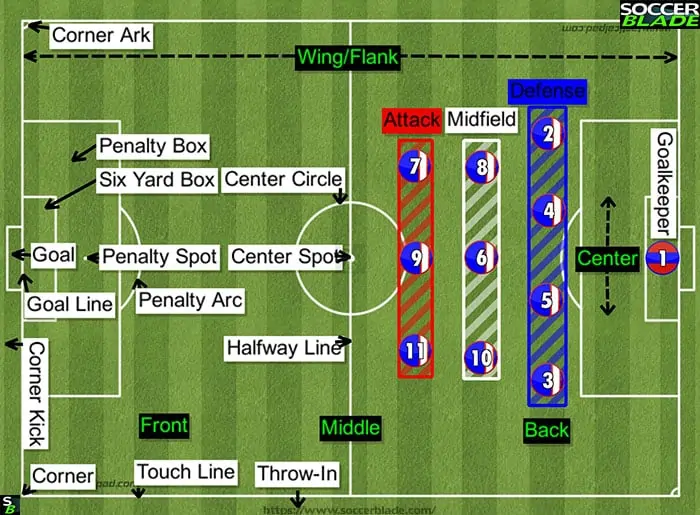
Law 2: The Ball
This law determines and regulates:
- Qualities and measurements of balls for professional games (e.g. material, pressure, and circumference)
- Process to replace defective balls
- Additional balls placed around the field for reintroduction when the ball goes out of play
Law 3: The Players
Law 3 outlines the most important rules regarding players, covering topics like:
- Number of players per team
- Number of substitutions per team
- The substitution procedure
- Replacing the goalkeeper
- Offenses and punishments for illegally substituting players
- Substitute sending-off procedure
- Players re-entering the field of play (e.g. after injury)
- Role of the team captain
Law 4: The Players’ Equipment
The players must wear specific equipment, are prohibited from wearing others, and follow clear rules regarding specific gear.
Law 4 describes all relevant information regarding players’ equipment. It covers factors such as:
- Safety (e.g. prohibited items that can cause injuries, such as rings, bracelets, and other types of jewelry)
- Compulsory equipment. Soccer players are required to wear:
- Sleeved shirt
- Shorts
- Socks
- Shinguards
- Footwear
- Goalkeepers (only) are permitted to wear tracksuit bottoms
- Team colors
- Teams must wear different colors from each other and game officials
- Goalkeepers must wear different colors to the outfield players
- Other equipment (non-dangerous)
- Slogans, statements, images, and advertising
- Punishments for breaking the rules regarding equipment
Law 5: The Referee
Law 5 discusses the role of the referee in soccer, covering factors such as:
- Referee’s authority
- Decision making protocols
- Referee’s powers and duties
- VAR
- The referee’s equipment
- Referee signals
- Referee responsibilities
It’s important to note that soccer’s laws, while simple, are subjective. This contributes to the free-flowing nature and artistic way the game is played.
Many in-game occurrences are subject to the discretion of the referee. Inevitably, certain on-field decisions are wrong or at least debatable.
However, referees are obligated to perform with the “spirit” of the game in mind, doing their best to make the correct rulings when instances occur.
IFAB is continually working on Law 5 to improve how the game is officiated.
This has led to the introduction and subsequent tweaking of the VAR. This also has allowed referees to change their decisions.
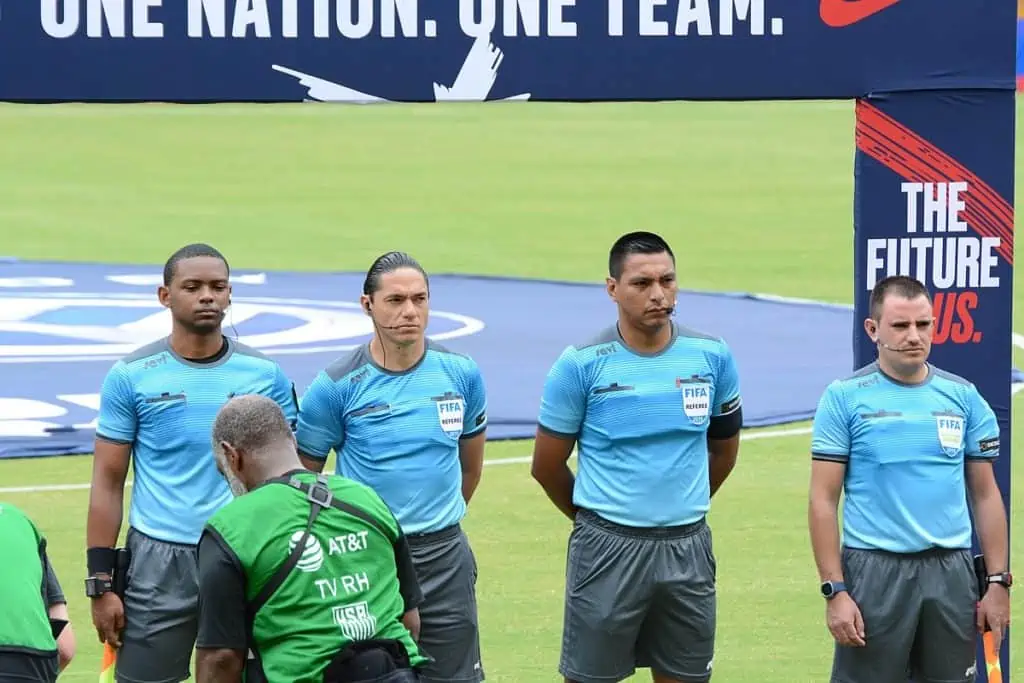
Law 6: The Other Match Officials
Law 6 is essentially an extension of Law 5 as it covers important aspects of all assistants’ roles, including:
- Assistant referees (linesmen and lineswomen)
- Fourth officials
- Additional assistants
- Reserve assistants
- Video officials
- Assistant referee signals
- Additional assistant signals
Law 7: The Duration of the Match (Game)
Soccer has a unique time-keeping system. Law 7 describes in detail how a game is split and covers factors such as:
- Periods of play (45-minute halves)
- Half-time interval (15-minute breaks between halves)
- Allowance for time lost (additional time added on at the end of halves for substitutions, fouls, other stoppages, etc.)
- Abandoning a game
Law 8: The Start and Restart of Play
Games don’t just start at the beginning of the half and end when time is up. There are several instances where the game is stopped.
Depending on the situation, the game is restarted in different ways. Starts and restarts include:
- Kick-off (at the beginning of each half, extra time, and extra time half time)
- Dropped ball (for certain stoppages like an injury)
- Free kick
- Goal kick
- Corner kick
- Penalty kick
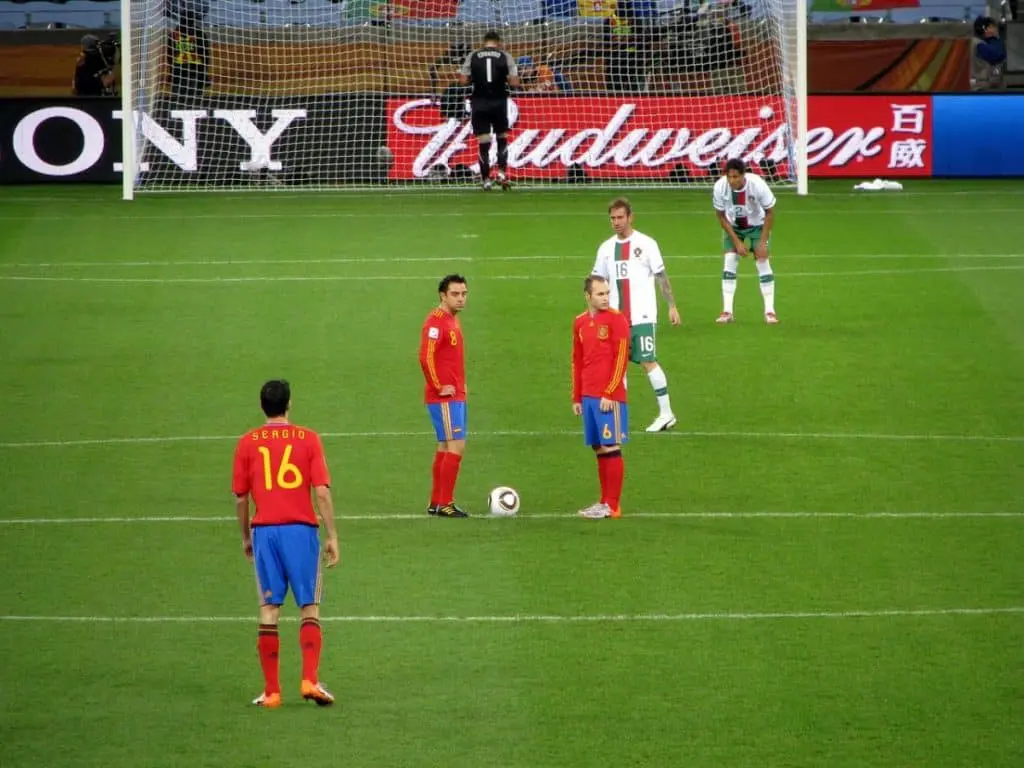
Law 9: The Ball in and Out of Play
This simple but important law describes when a ball is in or out of play. For example, the ball is out of play if:
- It has fully crossed over the sideline, goal line, or touchline, whether on the ground or in the air
- The referee blows his/her whistle to stop the game
- It touches a game official, and the touch has a significant impact on the game
The ball is in play once the game is live and it remains within the confines of the field.
Law 10: Determining the Outcome of a Match (Game)
Law 10 talks about the factors that determine the outcome of a game, such as:
- Goals scored
- Penalty shootouts
Law 11: Offside
Offside is one of the most important rules in the game of soccer. It influences formations, positioning, attacking styles, and defensive systems.
Check out our other article for the full breakdown of the offside rule in soccer and its impact on the game.
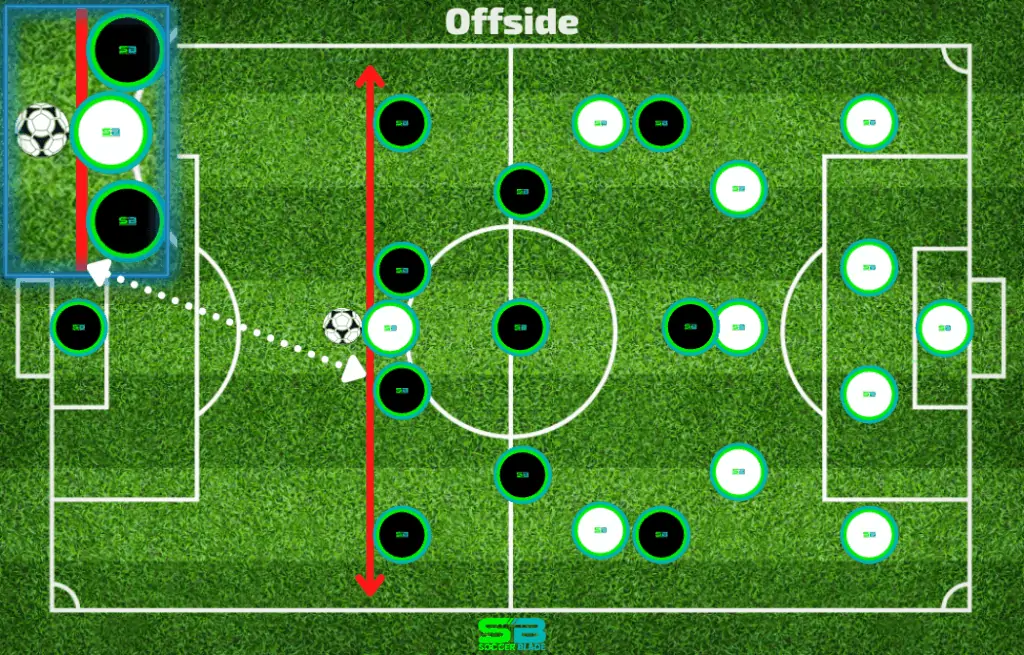
Law 12: Fouls and Misconduct
The fouls and misconduct section of the Laws of the Game is another key chapter that has a direct impact on the way the game flows, the outcome of the game, and how it’s enjoyed by fans.
We have another article that discusses exactly what constitutes a foul in soccer, as well as the repercussions for committing them.
Some of the most important aspects of Law 12 revolve around contact and the use of the hands and arms.
What Contact Is Allowed In Soccer?
Soccer is a contact sport. However, when compared to other games, like American football or boxing, it is far less physical. It’s important to be able to distinguish what is and isn’t a foul.
Now, let’s answer some questions regarding fouls and contact in soccer.
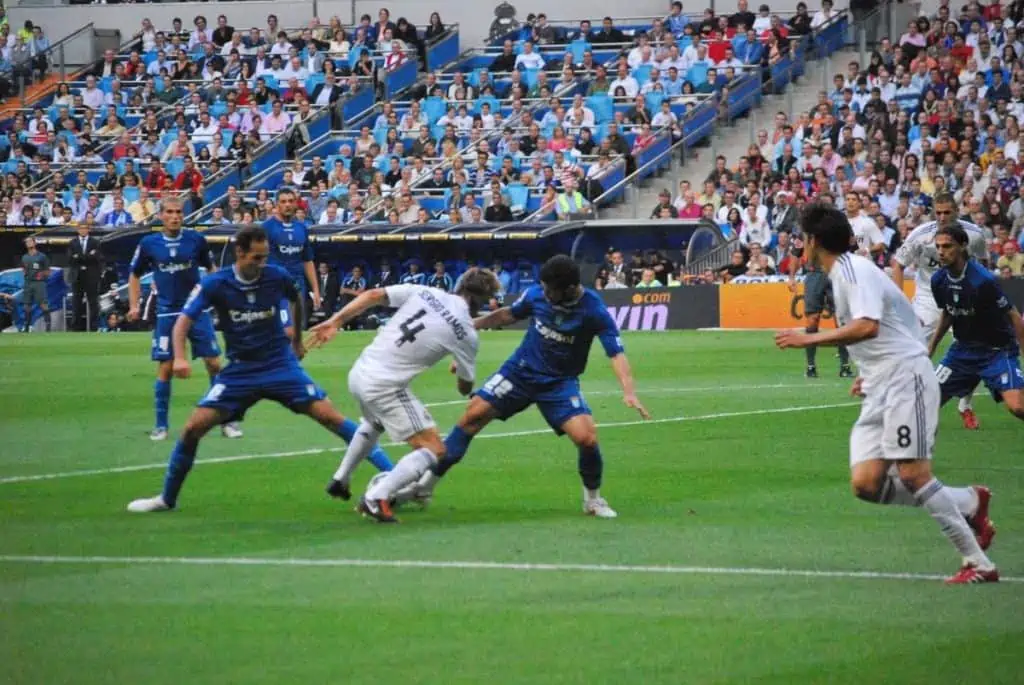
What Is A Foul In Soccer?
A foul is called when a player breaks one of the rules of the game.
It is typically punished with a free kick or penalty being awarded to the opposing team.
Severe fouls can result in yellow (warnings) and red cards (dismissal/ejection) being given to the offending player.
What Is Not Allowed In Soccer?
Direct free kicks are awarded for offenses that are careless, reckless, or carried out with excessive force. Contact that’s not allowed includes:
- Charging
- Jumping at an opponent
- Kicking or attempting to kick an opponent
- Pushing
- Striking or attempting to strike an opponent
- Tripping or attempting to trip an opponent
- Biting or spitting at an opponent, game official, or member of the coaching staff
- Handball
- Holding onto an opponent
- Impeding an opponent with direct contact
Penalties are awarded if any of these fouls occur inside a team’s penalty area.
What Is Charging In Soccer?
Charging is where a player imposes themselves aggressively and physically on an opponent carelessly, recklessly, or using excessive force.
As mentioned above, charging is a foul. Depending on the level of force, it may be punished with a yellow or red card.
Can You Block In Soccer?
Blocking or obstruction is illegal in soccer.
The foul occurs when one player impedes an opponent’s movement intentionally, making no effort to gain possession of the ball.
Can You Screen Someone In Soccer?
Screening, the basketball move, is not allowed in soccer.
However, shielding an opponent while you’re in possession is allowed as long as you do so without being careless, reckless, or using excessive force.
Is Holding a Foul in Soccer?
Holding is a foul in soccer.
Although some players get away with it during corners or free kicks, the introduction of VAR has helped clamp down on illegal holding.
Can You Use Your Arms In Soccer?
Unless you are a goalkeeper, you cannot use your arms to touch the ball in soccer.
Check out our other article on the handball rule.
Law 13: Free-Kicks
Law 13 describes:
- Different types of free kicks
- The procedure for taking free-kicks
- Offenses and sanctions
We have an article that explains the difference between direct and indirect freekicks here.
Law 14: The Penalty Kick
A penalty kick is awarded when the defensive team commits a foul in their own penalty box. A penalty is a 1 v 1 shot on goal from 12 yards between the taker and the goalkeeper.
Law 14 discusses the penalty procedure as well as offenses and sanctions.
Law 15: The Throw-In
Throw-ins are awarded when the ball goes out over the sideline. Law 15 goes through the legal technique of a throw-in as well as the potential outcomes.
Did you know you can’t score directly from a throw-in?
The throw-in technique is trickier than it might seem. However, it can be a real advantage to learn how to get some distance on your throws.
Stoke City’s Rory Delap haunted Premier League teams for years with his amazing technique and distance.
Law 16: The Goal Kick
Goal kicks are awarded when the entire ball passes over the end line (not inside the goal) after touching a player from the attacking team.
- Did you know a goal can be scored directly from a goal kick?
Law 17: The Corner Kick
Law 17 covers all aspects of the corner kick, including why it’s awarded and what the corner procedure is.
Corner kicks are taken from a small triangular segment next to the corner flag. A corner is awarded when the entire ball passes over the end line (not inside the goal) after touching a player from the defending team.
Common Soccer Rule Questions
What Is The Yellow Card In Soccer?
A yellow card is a caution given to players who commit a serious offense. If a player receives 2 yellow cards, it equates to a red, resulting in the player being ejected from the game.
What Is The Red Card In Soccer?
A red card is given to a player who commits a sending-off offense. They are ejected from the game and cannot be replaced by a substitute.
A player can receive a straight red card for a very severe foul. Or, as mentioned, 2 yellows equals a red.
How Many Rules Are There In FIFA?
FIFA recognizes IFAB’s 17 Laws of the Game for all of its tournaments.
Can You Wear Earrings In Football?
Wearing earrings and other jewelry such as bracelets and rings is prohibited in the interest of safety. In the past, players were allowed to cover earrings with tape. However, this became illegal several years ago.
How Does A Soccer Game Start?
Each half of a soccer game starts with a kick-off. The team that takes the opening kick-off is decided by a coin toss between the referee and the opposing captains.
Are Elbows Allowed In Soccer?
Intentional elbows to initiate contact with an opposition player are not allowed. An elbow is often punished with a red card. Accidental elbows are also illegal.
However, punishment may not be severe, with a free kick or yellow card being given to the offending player.
Does Soccer Have Interference?
Unlike American football, soccer doesn’t have an interference rule.
Can You Protect Your Face In Soccer?
Protecting your face with your hands is illegal. It is regarded as a handball. Heading is an important skill in soccer and unfortunately, players often have to put their heads where most wouldn’t put their feet.
For more common questions that players, fans, coaches, and parents have about the laws of soccer – we have compiled a list of 48 soccer rules listed from A-Z.
Joel is a seasoned soccer journalist and analyst with many years of experience in the field. Joel specializes in game analysis, player profiles, transfer news, and has a keen eye for the tactical nuances of the game. He played at various levels in the game and coached teams - he is happy to share his insight with you.



